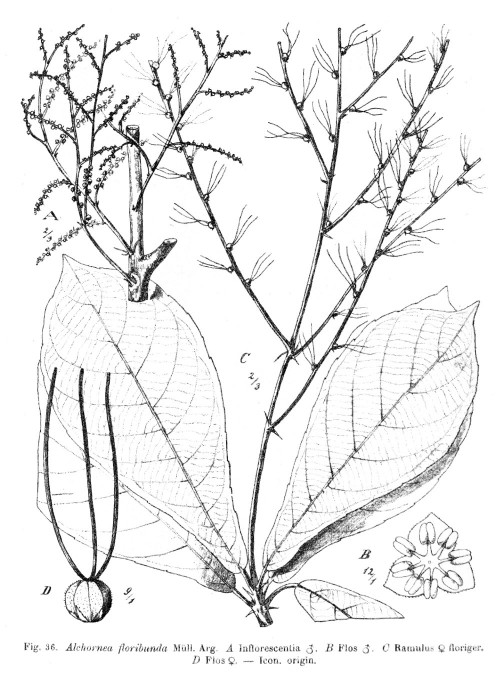Alchornea floribunda Müll. Arg. - Euphorbiaceae - Niando
Large shrub or small tree, 4.5-10m high, native to the tropical Africa; leaves on the ends of twigs, short petioled, laceolate-spatulate; male axillary inflorescences 10-25cm long, with pale green flowers; female inflorescences to 25cm long; fruit a capsule with shiny brown seeds.
„Alchornea floribunda leaves are widely used in African ethnomedicine for the management of acute and chronic inflammatory disorders… bioactivity-guided fractionation of the ethyl acetate fraction of the methanol leaf extract of the plant material led to the isolation of a new flavonol glycoside (AFF1). The anti-inflammatory activity of this novel compound was evaluated using egg albumen-induced rat paw oedema as a model of inflammation. AFF1 showed significant inhibition of the rat paw oedema in a dose-dependent manner. The activity of AFF1 (50 mg kg−1) was higher than that of the standard anti-inflammatory drug, aspirin (100 mg kg−1). The compound also significantly (p < 0.001) inhibited heat-induced haemolysis of human erythrocytes in vitro. The structure of AFF1 was elucidated as 3,5,7,3′-tetrahydroxyflavone-3-O-α-L-rhamnoside, using a combination of UV, IR, 1D and 2D (COSY) 1H-NMR spectroscopy. This compound, in part, accounts for the anti-inflammatory effect of A. floribunda leaves.“
[A new anti-inflammatory flavonol glycoside from Alchornea floribunda leaves., Okoye, F.B.C., Osadebe, P.O., Natural product research, 24(3), 2010, 266-273]
As the leaves of Alchornea floribunda and Alchornea cordifolia are used traditionally as topical anti-inflammatory agents, two highly lipophilic fractions isolated from A. floribunda and A. cordifolia leaves were investigated for topical anti-inflammatory effects using xylene-induced mice ear oedema. Compared to indomethacin, these fractions showed significantly higher topical anti-inflammatory effect. The leaf extract of A.floribunda was composed mainly of long chain saturated and unsaturated hydrocarbons (18.7%) and their oxygenated derivatives (1.8%), while the A.cordifolia leaf extract was rich in volatile oil with eugenol (21.2%), cadinol (4.6%), nanocosaine (36.8%) and steroid derivatives, ethyl iso-allocholate (4.5%) and 3-acetoxy-7,8-epoxylanostan-1-ol (15.8%).
[Topical anti-inflammatory constituents of lipophilic leaf fractions of Alchornea floribunda and Alchornea cordifolia., Okoye, F.B.C., Osadebe, P.O., Nworu, C.S., Okoye, N.N., Omeje, E.O., Esimone, C.O., Natural product research, 25(20), 2011, 1941-1949]
„Alchornea floribunda Müll. Arg. is used in traditional medicine across Africa for the treatment of bacterial, fungal, parasitic and inflammatory disorders… Extracts of roots, stems and leaves were prepared using solvents of various polarities in order to extract a wide range of phytochemicals. The antibacterial activity of these crude extracts was evaluated by micro-dilution assay, against Gram-positive (i.e. Bacillus cereus, Enterococcus faecalis, Staphylococcus aureus and Staphylococcus saprophyticus) as well as Gram-negative (i.e. Escherichia coli, Klebsiella pneumoniae, Moraxella catarrhalis and Proteus mirabilis) bacteria… the ethanolic leaf extract was the most active against Staphylococcus aureus with an MIC value of 50 µg/mL. Some other notable activity was observed for the ethyl acetate and chloroform root extracts against Staphylococcus aureus (50 µg/mL), and for selected stem extracts against Staphylococcus aureus (50 µg/mL), Klebsiella pneumoniae (63 µg/mL) and Staphylococcus saprophyticus (63 µg/mL).“
[Antibacterial activity of the roots, stems and leaves of Alchornea floribunda., Noundou, X.S., Krause, R.W.M., van Vuuren, S.F., Ndinteh, D.T., Olivier, D.K., Journal of ethnopharmacology, 151(2), 2014, 1023-1027]

Engler, H.G.A., Das Pflanzenreich, Euphorbiaceae - Acalypheae - Mercurialinae, vol.147 [Heft 63], p.240, f.36 (1914)
http://plantgenera.org/species.php?id_species=37203